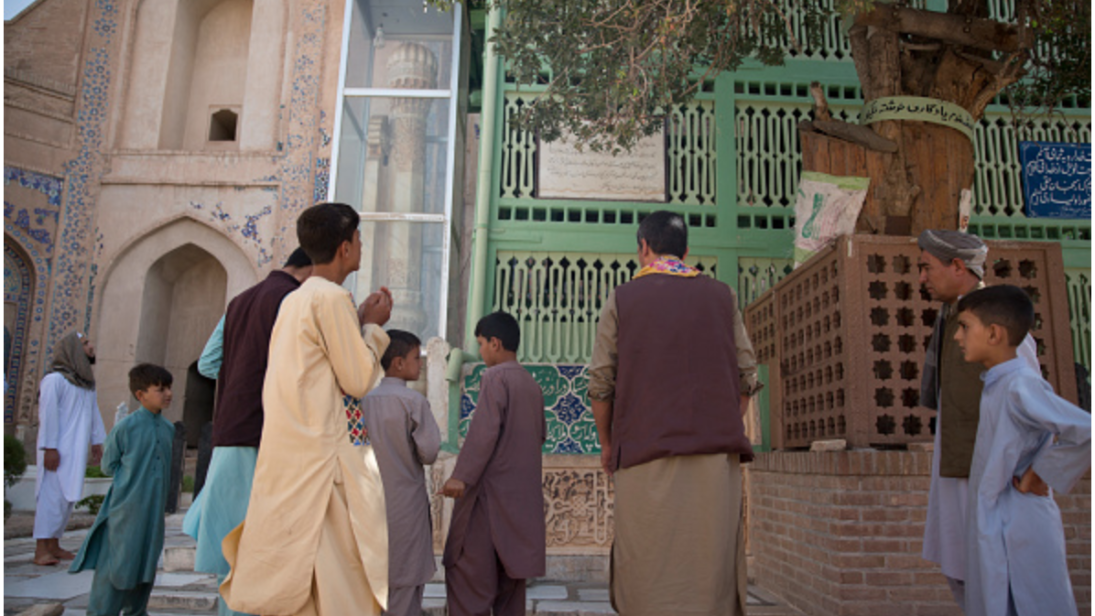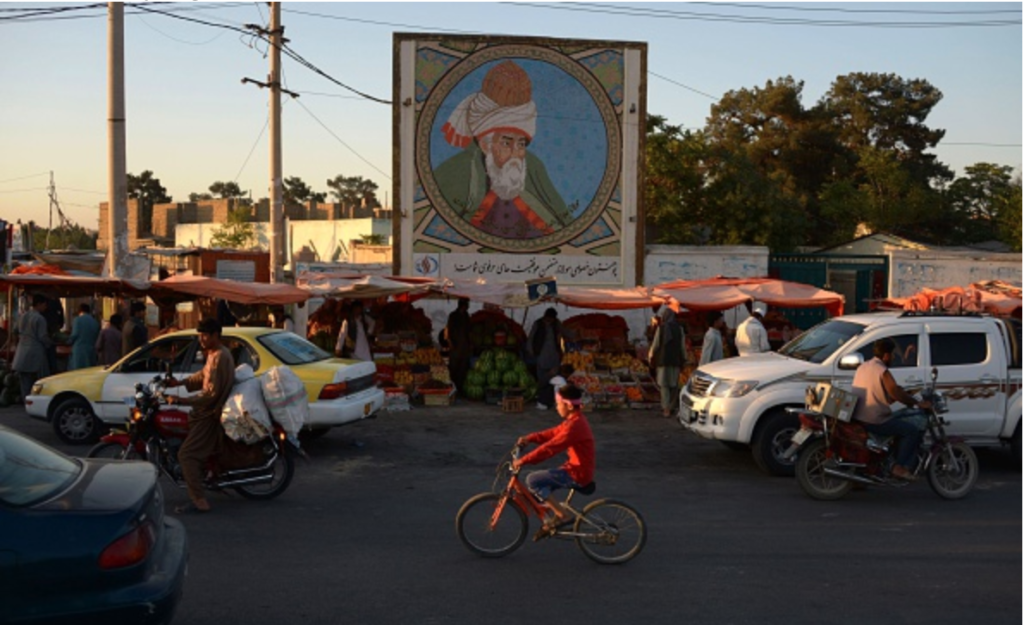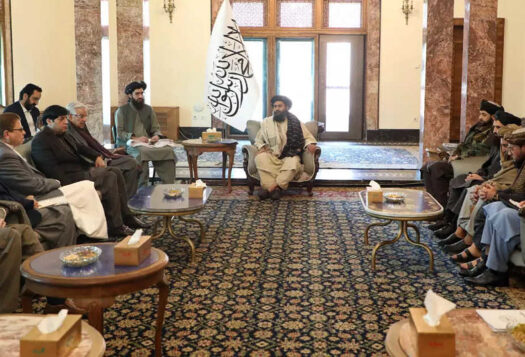
Since the Taliban swiftly took Kabul in August, Afghans and Afghanistan watchers have been grappling with what the shape and nature of the new government will be and how it will replace the former republic. There is little hope left for democracy: former President of Afghanistan, Ashraf Ghani fled to the United Arab Emirates and many other members of his government took refuge in Western countries. Yet many politically influential figures which had served in past governments, including members of the two Sufi mystical families—Gilani and Mujaddadi—remain in Kabul.
Sufism is a mystical form of Islam that emphasizes inner purification and rejection of the self to build connection with God. The Sufi families represent an institutionalization of Sufism in the form of a Silsila—the chain of spiritual knowledge and leadership. Originally, the order ran from Prophet Muhammad on the basis of teacher-student transfer of knowledge while the nasab donated the exclusive divinity attached with the family of the Prophet. Later the Sufi Silsila and nasab were merged, with certain families becoming authorities of Sufi orders in different regions. A unique strength of Sufism lies in its accommodative approach towards local cultural practices. So as Islam spread to Afghanistan, these mystics were able to embed Islamic beliefs within Pashtun culture. Some mystical families—particularly Naqshbandi—earned the political patronage of Muslim Pashtun rulers and assumed important positions in the royal courts. Despite playing an important political role in Afghanistan for centuries in the past, these Sufi leaders, often called traditionalists, have, over the last three decades, gradually lost their political prominence. Yet they retain an important social stature and influence over a large segment of Afghan society stemming from their religious role and status. Hence, these mystical political families are important for winning public support.
Many have overlooked the political role these mystics could play in a Taliban-led Afghanistan. This is largely because analysts draw a flawed dichotomy between “moderate” and “extreme” interpretations of Islam, placing tolerant Sufis in the former category and dogmatic Taliban members in the latter. Not only have the mystics collaborated with other conservative political actors in the past, they also supported a negotiated settlement with the Taliban over military action. The composition of the Taliban has evolved too: not all post-2001 recruits are Madrassah students, and there is greater diversity of ideology and motive, with many members having received religious education from mystics. The Taliban would also prefer to work with mystical traditionalists over nationalists and liberals. If the Taliban holds true to its signaling about a more inclusive government sharing power with non-Taliban leadership, these mystical orders could play a role in the future political order of Afghanistan.
Not only have the mystic collaborated with other conservative political actors in the past, they also supported a negotiated settlement with the Taliban over military action.
Correcting the Western Misperception of Sufism
Sufi mystics have cultivated a strong and more multifaceted political role in Afghanistan, extending their influence beyond the spiritual realm. They were the kingmakers, advisors to courts, peace brokers, and leaders of resistance movements. The head of Gailani and Mujaddadi families, belonging to Qadariya and Naqshbandia Sufi orders respectively, had actively fought against Soviet Invasion. Years of rising radicalism in the region and harsh Taliban rule in 1990s led many mystics to leave Afghanistan or go into hiding. The Taliban was specifically critical of the Shrine culture—particularly of music and dance more commonly practiced by the Chistiya order—and issued harsh punishment to mystics involved in these activities.
When U.S. forces toppled the Taliban government in 2001, the leaders of both Sufi families resumed their political activism. And when U.S. policy goals shifted from counterterrorism to nation building, many scholars recommended focusing on the role Sufi mystics could play in building “Civil Democratic Islam” to counter “Islamic extremism.” There were two key flaws in this approach. First, it treats Sufism and radicalism as two rival versions of Islam on either end of a polarized spectrum. Experts on political Islam, however, reject this categorization as superficial and oversimplified. In Afghanistan, Sufi mystics have made alliances with “radical” Salafis and Deobandi political groups. During Soviet-Afghan war, both Sufi families chose to align with the Pakistan-led Sunni Mujahedeen group instead of an Iran-led Shia group deemed closer to Sufi Islam. Despite the harsh treatment Sufi orders faced at the hands of the Taliban, they formed an opposition political group that pressed Karzai and Ghani government to settle dispute through negotiation with the Taliban. The Taliban’s Pashtun ethnic identity may have contributed to this since mystics were historically closer to Pashtuns. Because U.S. policy in Afghanistan initially focused on militarily defeating the Taliban, instead of negotiating with them, mystics had a limited role to play in U.S.-sponsored efforts for peace.
Assuming Sufis are natural rivals of the Taliban misinterprets the mysticism and comparative tolerance of Sufism as more akin to Western liberal ideology.
Second, assuming Sufis are natural rivals of the Taliban misinterprets the mysticism and comparative tolerance of Sufism as more akin to Western liberal ideology. Mystics in Afghanistan have militarily participated in several resistance movements, including the ones against colonial masters attempting to impose a liberal political order in the region. The current Sufi leadership in Afghanistan follows a pluralist but equally non-secular and conservative model of politics. While it is true that mystical orders in Afghanistan can play a vital role in bringing peace to the region—they promote negotiated political settlement and are less ideologically dogmatic—they oppose Western liberalism just as much the Taliban does. These traditionalists were also harsh critics of the Ashraf Ghani-led government for its liberal policies and are likely to support the Taliban in its effort to build an Islamic government in Afghanistan.

The Complicated Relationship between the Taliban and Sufis
While Taliban leadership in the 1990s banned several Sufi practices and adopted a harsh policy towards Sufi mystics, “staunch rivalry” is not an apt characterization of their relationship with Sufi political families. Most members of the Taliban follow the Deobandi School of thought that does not reject Sufism but opposes several practices of Sufi Shrine culture. Brandon D. Ingram, in his work “Is the Taliban Anti-Sufi” found no “reflexively anti-Sufi stance among Deobandi antecedents of the Taliban.” In fact, many mystics supported the Taliban initially in its efforts to end civil war in Afghanistan as they prefer an Islamic government to a Western-sponsored regime. Later, due to the staunch policies of Mullah Umer, who decided to form a totalitarian government, the mystical orders lost their political clout in the country. Some still claim that the Taliban did not ban many Sufi activities — particularly for the Naqshbandia order, which Mullah Umar once followed.
The present-day Taliban is believed to be ideologically more diverse and less extreme than their 1990s predecessors, including many followers of Sufism; as a result, it faces fewer obstacles in cultivating ties with the Sufi political families. Partnerships with mystical families could help the Taliban gain its government international recognition—they can use the pacifist and moderate perception of these mystics to their advantage. As these mystics still hold a strong following among the Afghan public, alliance with the Sufi mystics can also help the Taliban win political legitimacy and support on the domestic front. On the other hand, Sufi mystics are believed to hold influence over the pro-Sufi elements within the Taliban as well as other political groups, encouraging them to resolve the problems in Afghanistan through peaceful settlement—a goal for which they have increasingly signaled resolve.
Conclusion
While it is true that Sufism promotes a tolerant and pluralist social order, it is wrong to perceive the mystics in Afghanistan as pro-Western liberals and, in turn, rivals of the Taliban. The Sufi political families in Afghanistan have historically collaborated with other conservative political groups that follows the same Deobandi ideology as the Taliban and have opposed and criticized the U.S. military approach towards the Taliban. If the ideological evolution in the Taliban—which now claims to support a policy of peaceful political settlement in Afghanistan—comes to fruition, converging political objectives makes the mystics the Taliban’s natural partner. The Sufis are both legitimately more tolerant and better perceived in international circles and can help the Taliban win both domestic support and international recognition.
***
Image 1: Robert Nickelsberg via Getty Images
Image 2: Farshad Usyan via Getty Images


